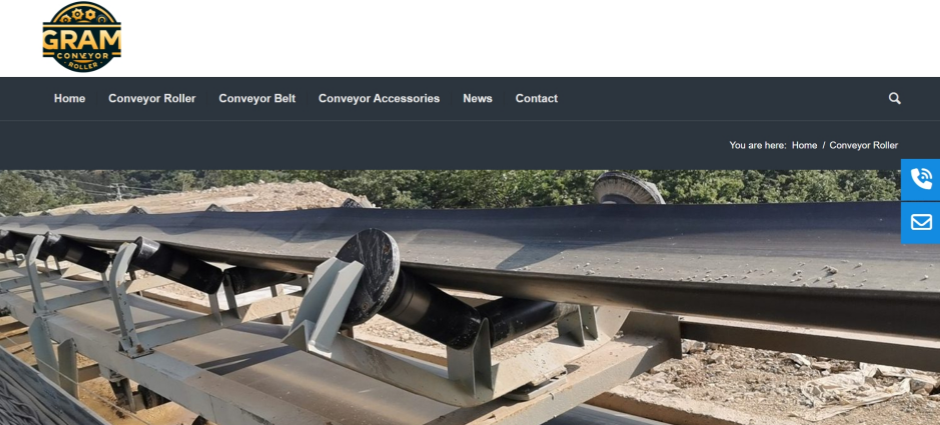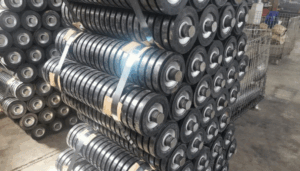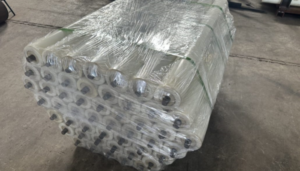HOME IMPROVEMENT
Essential Insights into Conveyor Impact Rollers: Design, Applications, and Maintenance

Conveyor impact rollers are essential components in material handling systems, designed to absorb and reduce the impact of heavy loads and sharp-edged materials on conveyor belts. They play a crucial role in protecting both the conveyor system and the transported goods, ensuring smooth and efficient operations. Conveyor rollers, in general, are vital for the efficient movement of goods, and among them, nylon conveyor rollers have gained prominence due to their exceptional properties. Known for their durability, lightweight nature, and resistance to corrosion, nylon rollers offer significant advantages over traditional materials. Their low friction and noise reduction capabilities make them ideal for various industrial applications, from manufacturing to logistics. This article delves into the benefits, applications, and future trends of nylon conveyor rollers in modern industry.
Key Features of Conveyor Impact Rollers
Design and Construction
Conveyor impact rollers are meticulously designed to endure the harshest conditions in material handling environments. Typically constructed with a robust steel shell, these rollers are built to provide a sturdy framework that can withstand heavy impacts. The core of the roller often includes shock-absorbing materials such as rubber rings or discs, strategically placed to cushion the impact and reduce wear on the conveyor belt. The design also incorporates high-quality bearings that ensure smooth rotation and longevity. Additionally, the outer surfac
e of impact rollers is treated or coated to resist abrasion and corrosion, enhancing their durability and operational efficiency.
Impact Absorption Capabilities
The primary function of impact rollers is to absorb and dissipate the energy from heavy or sharp-edged loads, preventing damage to the conveyor belt and extending its service life. The shock-absorbing elements within the rollers, such as rubber rings, are crucial for this purpose. These elements compress under the weight of the load, effectively cushioning the impact and reducing the stress on the entire conveyor system. This absorption capability not only protects the belt but also minimizes the risk of material spillage and damage t
o the transported goods, ensuring a smooth and reliable operation.
Common Sizes and Dimensions
Conveyor impact rollers come in various sizes and dimensions to accommodate different conveyor systems and applications. Common diameters range from 89 mm to 159 mm, with lengths varying to suit specific conveyor widths. The shaft diameter and bearing size are also critical specifications, typically standardized to fit seamlessly into existing conveyor frameworks. Custom sizes are often available to meet unique operational requirements, ensuring that the rollers can handle specific load capacities and impact conditions effective
ly.
Role of Nylon in Impact Rollers
Nylon plays a significant role in enhancing the performance of conveyor impact rollers. As a material, nylon offers several beneficial properties, including high tensile strength, excellent wear resistance, and low friction. These characteristics make nylon an ideal choice for the shock-absorbing components within impact rollers. Nylon’s flexibility and resilience allow it to absorb shocks efficiently, reducing the wear and tear on both the rollers and the conveyor belt. Additionally, nylon’s resistance to moisture and chemicals ensures longevity and reliability in diverse industrial environments. The lightweight nature of nylon also contributes to easier handling and installation, further enhancing its suitability for impact roller applications.
By incorporating these key features
, conveyor impact rollers ensure robust performance, protecting conveyor systems and optimizing material handling processes across various industries.

Applications of Conveyor Impact Rollers
Mining
In the mining industry, conveyor impact rollers are indispensable for handling the heavy loads and harsh conditions typical of mining operations. These rollers are used to transport large quantities of ore, rocks, and other raw materials. The robust design and impact absorption capabilities of these rollers protect the conveyor belts from the significant wear and tear caused by the heavy, abrasive materials. The integration of nylon conveyor rollers in mining operations further enhances durability and efficiency. Nylon’s resistance to moisture and chem
icals ensures that the rollers can withstand the demanding environment of mines, reducing maintenance needs and extending the lifespan of the conveyor systems.
Construction
Conveyor impact rollers are also widely used in the construction industry to move building materials such as sand, gravel, and concr
ete. These rollers help in managing the high impact loads generated when heavy construction materials are dropped onto the conveyor belts. The shock-absorbing properties of impact rollers prevent damage to the conveyor system, ensuring continuous and efficient operation. Nylon conveyor rollers are particularly beneficial in construction applications due to their lightweight nature and ease of installation. They provide excellent impact resistance and help reduce operational noise, making construction sites more efficient and safer.
Heavy Manufacturing
In heavy manufacturing industries, conveyor impact rollers play a crucial role in the transportation of large, heavy parts and assemblies. These rollers are designed to handle the substantial impacts and stresses associated with the movement of heavy machinery components and industrial products. The durability and impact absorption capabilities of these rollers are essential for maintaining the integrity of the conveyor systems and ensuring the smooth flow of materials through the manufacturing process. Nylon conveyor rollers are integrated into heavy manufacturing applications to enhance performance. The high tensile strength and wear resistance of nylon make it ideal for managing the rigorous demands of heavy manufacturing, reducing downtime and maintenance costs.
Integration of Nylon Conveyor Rollers in These Applications
The integration of nylon conveyor rollers across various applications in mining, construction, and heavy manufacturing brings numerous benefits:
- Durability and Longevity: Nylon rollers provide superior durability, reducing the frequency of replacements and extending the service life of conveyor systems. This is particularly beneficial in harsh environments like mines and construction sites.
- Reduced Maintenance: The wear resistance and low friction properties of nylon minimize maintenance requirements, saving time and costs associated with frequent repairs and replacements.
- Noise Reduction: Nylon rollers operate more quietly than traditional metal rollers, which is advantageous in noise-sensitive environments such as construction sites and manufacturing plants.
- Lightweight and Easy Installation: The lightweight nature of nylon makes the rollers easier to handle and install, improving operational efficiency and reducing labor costs.
- Resistance to Environmental Factors: Nylon’s resistance to moisture, chemicals, and abrasion ensures reliable performance in diverse industrial settings, from wet and corrosive mining environments to dusty construction sites.
By leveraging the unique properties of nylon, conveyor impact rollers enhance the efficiency, durability, and overall performance of material handling systems in these critical industries.
Sizing and Selection of Conveyor Impact Rollers
Importance of Correct Sizing
Selecting the correct size of conveyor impact rollers is crucial for ensuring the efficiency and longevity of a conveyor system. Properly sized rollers help distribute the load evenly, reducing the risk of belt damage and system malfunctions. Incorrect sizing can lead to increased wear and tear, higher maintenance costs, and potential operational downtime. By matching the roller size to the specific requirements of the application, businesses can optimize material flow, enhance productivity, and minimize operational disruptions.
Guide to Choosing the Right Size
- Load Capacity: Determine the maximum load that the conveyor system will handle. The rollers must be able to support the weight without deformation or excessive wear. This involves calculating the combined weight of the transported materials and considering dynamic impacts.
- Roller Diameter: The diameter of the roller should be selected based on the load and belt speed. Larger diameters provide better load support and reduce rotational speed, which can minimize wear. Common diameters range from 89 mm to 159 mm, but the choice depends on specific operational needs.
- Roller Length: The length of the rollers should match the width of the conveyor belt to ensure even load distribution. Custom lengths can be made to fit unique conveyor designs and applications.
- Shaft Diameter and Bearing Size: Ensure that the shaft diameter and bearing size are compatible with the conveyor system. These components need to support the rotational forces and provide smooth operation. Standard sizes are often available, but custom options may be necessary for specific requirements.
- Environmental Conditions: Consider the operating environment, including temperature, humidity, and exposure to chemicals or abrasives. These factors influence the choice of materials and coatings for the rollers.
Customization Options
Customization options for conveyor impact rollers are available to meet unique operational requirements:
- Material Selection: While standard impact rollers may use steel or other metals, nylon rollers offer a lightweight, corrosion-resistant alternative that can be tailored to specific applications.
- Coatings and Treatments: Rollers can be coated with various materials to enhance their durability and resistance to environmental factors. For example, rubber or polyurethane coatings can improve impact absorption and reduce noise.
- Dimensions: Custom dimensions, including roller diameter, length, and shaft size, can be specified to fit non-standard conveyor systems or unique load conditions.
- Shock-Absorbing Elements: The type and arrangement of shock-absorbing materials, such as rubber rings or discs, can be customized to optimize impact absorption for specific applications.
Benefits of Nylon Material in Impact Roller Customization
Nylon offers several advantages when used in the customization of impact rollers:
- Durability: Nylon’s high tensile strength and wear resistance make it ideal for handling heavy loads and abrasive materials, extending the roller’s service life.
- Lightweight: Nylon rollers are significantly lighter than metal alternatives, making them easier to handle and install. This reduces labor costs and installation time.
- Corrosion Resistance: Nylon’s resistance to moisture and chemicals makes it suitable for use in harsh environments, such as mining and food processing, where exposure to corrosive substances is common.
- Low Friction: The low friction coefficient of nylon reduces energy consumption and wear on the conveyor belt, improving overall system efficiency and reducing operational costs.
- Noise Reduction: Nylon rollers operate quietly, which is beneficial in environments where noise reduction is important, such as manufacturing plants and distribution centers.
By carefully considering these factors and leveraging the customization options available with nylon materials, businesses can select the most appropriate conveyor impact rollers for their specific needs, ensuring optimal performance and longevity of their conveyor systems.
Conveyor Impact Roller Manufacturers
Market Leaders
Several companies have established themselves as market leaders in the production of conveyor impact rollers. These companies are recognized for their commitment to quality, innovation, and customer satisfaction. Among the most notable are:
- GRAM Conveyor: Known for its high-quality rollers and advanced manufacturing processes, GRAM Conveyor is a key player in the industry. They offer a wide range of conveyor rollers tailored to various applications, ensuring durability and efficiency.
- Damon Industry: With a global presence, Damon Industry is renowned for its comprehensive portfolio of conveyor rollers. Their products are used in numerous industries, from logistics to mining, demonstrating their versatility and reliability.
- Interroll Group: Interroll Group is another prominent manufacturer, offering a variety of conveyor rollers designed for different industrial applications. Their focus on innovation and sustainability sets them apart in the market.
Innovations and Technologies
Leading manufacturers are continuously innovating to improve the performance and efficiency of conveyor impact rollers. Some of the key advancements include:
- Smart Technology: Integration of smart sensors in rollers to monitor performance in real-time. These sensors can detect wear, temperature changes, and operational anomalies, allowing for predictive maintenance and reducing downtime.
- Advanced Materials: Development of new materials and composites, such as enhanced nylon blends, that offer superior strength, flexibility, and resistance to wear and environmental factors.
- Precision Manufacturing: Utilization of cutting-edge manufacturing techniques like CNC machining and automated assembly lines to ensure high precision and consistency in roller production.
- Eco-Friendly Solutions: Focus on sustainability by developing rollers made from recycled materials and implementing energy-efficient manufacturing processes.
Quality and Durability Considerations
When selecting a manufacturer for conveyor impact rollers, quality and durability are paramount. Key considerations include:
- Material Quality: High-quality raw materials, such as premium-grade nylon, are essential for producing durable and reliable rollers. Manufacturers should adhere to strict quality control standards to ensure material integrity.
- Manufacturing Standards: Companies that follow rigorous manufacturing standards and certifications (e.g., ISO) provide assurance of consistent product quality and performance.
- Testing and Validation: Reputable manufacturers conduct extensive testing and validation of their products, including load testing, impact resistance, and longevity trials, to ensure they meet industry standards and customer requirements.
- Customer Support: Excellent customer support and after-sales service are crucial. Manufacturers that offer comprehensive support, including installation assistance, maintenance services, and technical advice, add significant value to their products.
Leading Manufacturers of Nylon Conveyor Rollers
Several manufacturers are particularly noted for their expertise in producing nylon conveyor rollers:
- GRAM Conveyor: As a market leader, GRAM Conveyor excels in producing high-quality nylon rollers. Their products are known for their durability, low maintenance, and exceptional performance in various industrial applications.
- Damon Industry: Damon Industry offers a wide range of nylon conveyor rollers that are designed to meet the demanding needs of industries such as logistics, manufacturing, and food processing. Their focus on innovation ensures that their products remain at the forefront of the market.
- Interroll Group: Interroll Group’s nylon conveyor rollers are renowned for their precision engineering and robust construction. They are widely used in industries where high performance and reliability are critical.
- Rulmeca: Rulmeca specializes in producing rollers for heavy-duty applications, including nylon impact rollers. Their products are designed to withstand harsh environments and heavy loads, making them a preferred choice in industries like mining and construction.
By focusing on quality, innovation, and customer satisfaction, these leading manufacturers ensure that their nylon conveyor rollers meet the highest standards of performance and reliability. Businesses can rely on these manufacturers to provide the solutions needed to enhance the efficiency and longevity of their conveyor systems.
Maintenance and Care for Conveyor Impact Rollers
Routine Inspection and Maintenance
Regular maintenance and inspection are crucial for ensuring the optimal performance and longevity of conveyor impact rollers. Key steps include:
- Scheduled Inspections: Establish a routine inspection schedule to check for wear, alignment, and proper functioning of the rollers. Inspections should be conducted weekly or monthly, depending on the usage intensity and operating conditions.
- Cleaning: Keep the rollers clean from debris, dust, and other contaminants. Regular cleaning prevents buildup that can cause operational issues and increase wear on the rollers and conveyor belt.
- Lubrication: Ensure that the bearings and other moving parts are adequately lubricated to reduce friction and wear. Use appropriate lubricants recommended by the roller manufacturer.
- Alignment Check: Verify that the rollers are properly aligned with the conveyor belt to prevent uneven wear and potential damage. Misalignment can lead to increased friction and operational inefficiencies.
Troubleshooting Common Issues
Addressing common issues promptly can prevent minor problems from escalating into significant failures:
- Excessive Noise: Noise can indicate issues such as misalignment, worn bearings, or debris caught in the rollers. Inspect and rectify the root cause promptly.
- Roller Skipping or Slipping: This can be caused by improper tension in the conveyor belt or worn roller surfaces. Adjust the belt tension and replace rollers if necessary.
- Uneven Wear: Uneven wear on the rollers may result from misalignment or imbalanced loads. Check the alignment and load distribution, and adjust accordingly.
- Roller Jamming: Jamming can occur due to foreign objects or buildup within the roller system. Regular cleaning and inspections can help prevent this issue.
Extending the Lifespan of Rollers
To maximize the service life of conveyor impact rollers, implement the following practices:
- Preventive Maintenance: Regular preventive maintenance helps identify and address potential issues before they cause significant damage. This includes scheduled inspections, cleaning, and lubrication.
- Quality Components: Use high-quality rollers and replacement parts to ensure durability and reliable performance. Investing in quality components reduces the frequency of replacements and repairs.
- Proper Training: Ensure that personnel operating and maintaining the conveyor system are adequately trained. Proper handling and maintenance practices can significantly extend the life of the rollers.
- Environmental Control: Minimize exposure to harsh environmental conditions, such as extreme temperatures, moisture, and corrosive substances. Protective covers or enclosures can help shield the rollers from adverse conditions.
Maintenance Tips Specific to Nylon Impact Rollers
Nylon impact rollers have unique properties that require specific maintenance considerations:
- Temperature Monitoring: Nylon can be sensitive to extreme temperatures. Ensure that the operating environment remains within the recommended temperature range to prevent material degradation.
- Chemical Exposure: While nylon is resistant to many chemicals, prolonged exposure to certain substances can cause damage. Regularly inspect rollers for signs of chemical damage and avoid using harsh cleaning agents.
- Load Management: Avoid overloading the conveyor system. Although nylon rollers are durable, excessive loads can lead to premature wear and deformation.
- Replacement Timing: Monitor the condition of nylon rollers closely and replace them at the first signs of significant wear or damage. Timely replacement prevents further damage to the conveyor system and ensures continuous operation.
By adhering to these maintenance practices, businesses can ensure the reliable performance and extended lifespan of their conveyor impact rollers. Proper care and routine inspections not only enhance operational efficiency but also reduce maintenance costs and downtime, contributing to overall productivity.
HOME IMPROVEMENT
Your Partner in Clean: Commercial Cleaning Experts

Ever wonder why some places always look neat, bright, and fresh each day?
A clean space helps people feel calm, focused, and ready to get things done. For many busy workplaces, staying clean takes more than a quick sweep or wipe. If you’ve been trying to keep up or want better results, there’s a smarter way.
Keep reading to see how trained cleaning experts can make a big difference every day.
Clean Workspaces Boost Focus
It’s hard to focus when trash piles up or floors feel sticky under your shoes. A clean space helps your mind stay clear and your work move faster.
When everything looks neat, people feel more at ease and less stressed. Even the air can feel lighter in a well-kept space.
Clean work areas help limit distractions and reduce tension during the day. With less mess around, it’s easier to stay on track and finish tasks. A little cleaning goes a long way.
Tools That Get Results
Using the right tools makes a big difference in how clean things get. Strong vacuums, steady mops, and quiet machines help workers clean faster and better.
These tools reach deep corners and pick up more dirt than hands alone. They help save time while also making each task more complete. With better tools, cleaners work faster without missing the hard parts.
Each pass leaves the area looking fresher and feeling safer. Good gear helps get strong results and keeps things moving.
Trained People, Better Service
Cleaning takes more than wiping a surface or sweeping the floor. Trained cleaners spot small messes and know where to focus first. They move with care and work in a steady, thoughtful way each time.
Their timing, attention, and effort all help the job come out better. They clean deeper and faster because they know what each task needs.
That kind of skill doesn’t come by chance. It grows with training and time. A well-trained cleaner helps your space feel neat, safe, and fresh.
Flexible Cleaning Schedules
Some places need cleaning early, while others need it after everyone goes home. That’s why flexible cleaning hours can help so much in busy workplaces.
Every place runs on a different clock, and cleaning should fit right into that flow. Teams can come in during slow hours or once the day ends.
For those in or near the area, corporate cleaning services in Alabama and Tennessee often offer this kind of setup. It helps keep things clean without getting in the way of daily work.
Health Hazards Get Reduced
Germs can spread fast when floors, desks, and handles stay dirty for too long. A clean space helps stop that from happening and keeps people from getting sick at work.
Regular cleaning clears away dust, trash, and germs that build up each day. When the air feels fresh and the surfaces stay clean, people feel safer, too.
It also helps cut down on sneezing, coughing, and other signs of poor air. Clean areas lower the chance of sickness and make the space feel much better.
You Can’t Go Wrong With Commercial Cleaning Experts
A clean place helps people feel good and work better. When trained cleaners handle the job, you don’t have to worry about dust, mess, or germs. They know what to do and how to do it right.
With the right help, your space can stay neat every day. It saves time, keeps things safe, and makes your workplace a better place to be.
HOME IMPROVEMENT
Freephonenum: The Future of Hassle-Free Virtual Communication

In a world increasingly reliant on digital connectivity, freephonenum services have emerged as indispensable tools for privacy-conscious users, digital nomads, businesses, and online shoppers. Whether you’re trying to sign up for an app, verify your account, or manage customer relations, virtual phone numbers provide unmatched convenience and anonymity. As the demand for online identity protection grows, understanding how freephonenum solutions work and why they’re trending becomes essential for both individuals and organizations.
These services allow users to generate temporary or permanent virtual numbers without needing a physical SIM card or traditional phone line. They are fast becoming a staple for verification, communication, and even automation. In this in-depth guide, we’ll explore how freephonenum tools work, who should use them, key benefits, comparisons, and expert insights that will help you confidently navigate this powerful technology.
What Is a Freephonenum and Why Is It So Popular?
A freephonenum is a virtual telephone number that lets users send and receive messages or calls over the internet—typically without requiring a subscription or physical infrastructure. Unlike standard cellular plans, these numbers are accessible online and often used for one-time verifications or low-commitment communications.
What makes freephonenum platforms attractive is their low cost, ease of use, and privacy protection. These tools are ideal for situations where users don’t want to expose their personal numbers. From developers testing SMS functionality to users registering anonymously on social platforms, freephonenum services offer a layer of security that’s difficult to ignore.
Benefits of Using a Freephonenum Service
The value proposition of freephonenum tools extends far beyond simple convenience. Here are some of the leading benefits:
Privacy and Anonymity
Using a virtual number ensures your real phone number stays private. Whether signing up for newsletters or creating accounts, freephonenum keeps your personal data safe from spam and misuse.
Cost-Effective Communication
As the name suggests, most freephonenum services are either completely free or offer basic functionality without cost. This is a massive plus for startups, freelancers, or budget-conscious users.
Flexible and Disposable
Need a number just once? Many freephonenum platforms offer disposable numbers that you can discard after use. It’s ideal for one-time SMS verifications or avoiding long-term commitments.
No Hardware Required
Forget physical SIM cards or extra mobile devices. A stable internet connection is all you need to access a freephonenum.
Global Access
Some freephonenum services provide international numbers, making them excellent for businesses expanding into global markets or users wanting a local presence abroad.
Who Should Use a Freephonenum?
Freelancers and Remote Workers
Digital professionals often need to sign up for tools, test applications, or interact with international clients. A freephonenum offers flexibility without requiring a secondary phone.
Online Shoppers
For one-time deals or account verification, a virtual number protects your primary number from unsolicited marketing.
Small Businesses
Managing customer service or running SMS campaigns is easier when using a dedicated freephonenum. It enhances professionalism and keeps communications organized.
Developers
QA teams and software engineers can simulate phone number input, SMS validation, and other mobile features during testing without incurring costs.
Core Features of a Freephonenum Platform
The reliability and functionality of any freephonenum service depend on certain critical features. Let’s look at them:
Message Reception
Most platforms offer real-time message reception, which is crucial for verifications and alerts.
Call Forwarding
Some advanced options include forwarding incoming calls to a personal line or voicemail.
Number Rotation
Disposable and rotating numbers are useful for bypassing regional restrictions or avoiding blacklisting.
User Interface
A clean, simple dashboard makes it easier to manage multiple numbers and view message history.
Platform Compatibility
Whether you’re on desktop or mobile, most freephonenum solutions work across various operating systems and browsers.
Comparison Table of Leading Freephonenum Features
| Feature | Platform A | Platform B | Platform C | Platform D | Platform E |
|---|---|---|---|---|---|
| Cost | Free | Freemium | Free | Subscription | Free |
| Ease of Use | ★★★★★ | ★★★★☆ | ★★★★☆ | ★★★★★ | ★★★☆☆ |
| Efficiency | High | Medium | High | Very High | Medium |
| Number Variety | Global | Regional | Global | Global | Limited |
| SMS Delivery Speed | Fast | Moderate | Fast | Very Fast | Slow |
“The flexibility of virtual phone systems is transforming the way users approach digital communication,” says Dr. Jenna Alston, a telecommunication strategist with 15+ years of experience.
Common Use Cases for Freephonenum Solutions
Whether personal or business, the use cases are expansive:
- Signing up for online services (e.g., marketplaces, streaming platforms).
- Verifying OTPs for apps or social media accounts.
- Creating burner accounts for dating or classified ads.
- Managing customer inquiries via SMS.
- Testing SMS or voice features in software development.
Security Considerations When Using a Freephonenum
While freephonenum tools are convenient, not all platforms are equally secure. Some may reuse numbers across multiple users, exposing you to potential data leaks or hijacking.
Best Practices:
- Never use a freephonenum for banking or sensitive platforms.
- Clear your SMS history and avoid storing personal info.
- Use platforms with encryption and solid privacy policies.
Limitations to Keep in Mind
While highly versatile, freephonenum tools do have limits:
- Some services block verification from certain platforms.
- Numbers may get blacklisted if abused.
- Not ideal for long-term, professional communication unless upgraded.
If you plan to use a virtual number for extended business use, it’s worth considering premium versions or porting your number for long-term reliability.
Expert Insight: The Evolution of Virtual Communication
According to telecom expert Alex Herman, “We’re entering an era where phone numbers are no longer tied to hardware. Freephonenum tools exemplify this shift, allowing people to remain mobile, anonymous, and agile in how they communicate.”
This transformation is fueling the gig economy, supporting digital privacy, and enabling cross-border collaboration.
How to Choose the Right Freephonenum Tool
Selecting the right freephonenum service requires analyzing several factors:
Availability of Numbers
Opt for a platform that offers a wide range of numbers by region and purpose.
Delivery Speed
Check real-time performance, especially if using for 2FA or critical sign-ups.
3. User Reviews
Look for trusted ratings and community feedback on reliability.
Platform Support
Ensure compatibility with your mobile and desktop devices.
Extra Features
From call forwarding to auto-reply features, extra utilities can make a major difference.
Freephonenum vs. Temporary Phone Apps
| Criteria | Freephonenum Services | Temporary Phone Apps |
|---|---|---|
| Cost | Usually free | Often paid or limited trial |
| Registration | No sign-up needed | Requires app installation |
| Accessibility | Web-based, instant | Mobile only, slower setup |
| Anonymity | High | Medium |
| Customization | Limited | High |
The Legal Side: Are Freephonenum Tools Safe to Use?
Yes—when used ethically. While freephonenum services are legal in most countries, misuse (e.g., spam, fraud, or impersonation) is not. Always respect the terms of use and avoid platforms that allow unrestricted exploitation.
If you’re using these tools in a business context, it’s important to follow local regulations around virtual numbers and data protection. Misusing free numbers for shady activities could lead to permanent bans or worse—legal consequences.
Industry Forecast: What’s Next for Freephonenum Services?
Experts predict a surge in AI-driven verification systems, which may decrease the efficacy of traditional freephonenum services over time. However, hybrid solutions—combining temporary numbers with identity management APIs—will likely emerge as the next big trend.
Also, with growing awareness about data privacy, consumers will increasingly demand secure, transparent, and efficient communication alternatives—further boosting the relevance of freephonenum platforms in personal and professional environments.
Conclusion:
In today’s hyperconnected world, freephonenum is no longer just a workaround—it’s a smart, proactive choice for privacy, convenience, and digital efficiency. From businesses looking to streamline communication to individuals safeguarding personal details, this technology empowers users with control and flexibility.
As we advance into a privacy-first digital era, freephonenum will continue to play a critical role in reshaping how we engage online. With the right precautions, understanding, and use, virtual numbers can offer significant benefits with minimal drawbacks.
FAQ’s
What is a freephonenum used for?
A freephonenum is commonly used for receiving verification codes, registering for websites or apps, and managing online communications without revealing your personal number.
Is a freephonenum safe to use?
Yes, as long as it’s used for low-risk purposes like temporary sign-ups or testing. Avoid using it for banking or sensitive accounts.
Can I use a freephonenum for business?
Yes, many small businesses use virtual numbers for customer interaction, marketing, and automation, although premium versions are more suited for long-term reliability.
Are freephonenum services really free?
Most are free for basic SMS reception. Some offer paid upgrades for advanced features like voice calls, call forwarding, or dedicated numbers.
How do I know if a freephonenum is still active?
Messages will stop delivering if the number is inactive or blacklisted. Always test the number before using it on critical platforms.
Can a freephonenum be traced?
Since most freephonenum services don’t require registration, they’re hard to trace back to individuals. However, platforms may keep logs for security reasons.
HOME IMPROVEMENT
Autoclaved Aerated Concrete: The Smart Solution for Sustainable Construction

Autoclaved aerated concrete is a lightweight, thermally insulating, and energy-efficient building material created through a chemical reaction that expands a paste made from cement, sand, lime, gypsum, and aluminum. This mixture is then cured in a high-pressure steam chamber (autoclave), forming porous but strong blocks. Increasingly used in modern construction, autoclaved aerated concrete represents a sustainable and efficient choice.
As a prefabricated material, this type of concrete is known for its exceptional thermal insulation properties, as well as its low weight, making it easy to handle and significantly reducing construction time. Additionally, autoclaved aerated concrete is fire-resistant, mold-proof, and pest-resistant.
How is Autoclaved Aerated Concrete Manufactured?
The manufacturing process of autoclaved aerated concrete includes the following steps:
- Raw material preparation: Sand, cement, lime, and gypsum are mixed with water in a mixer.
- Adding the expansion agent: Aluminum reacts with the lime, releasing hydrogen and forming air bubbles.
- Pouring into molds: The mixture is poured into molds where it begins to rise.
- Autoclaving: The blocks are steam-cured under pressure, which gives them strength and dimensional stability.
- Cooling and storage: After drying, the autoclaved aerated concrete blocks are ready for delivery and installation.
Key Benefits of Autoclaved Aerated Concrete
Energy Efficiency
Due to its porous structure, autoclaved aerated concrete provides excellent thermal insulation, reducing energy consumption for heating and cooling. Buildings constructed with AAC can easily meet passive house standards.
Lightweight Construction
This material is 3–4 times lighter than conventional concrete, which, combined with its modular assembly system, results in superior handling and faster construction time.
Applications in Construction
Residential Housing
Autoclaved aerated concrete is the ideal choice for energy-efficient homes. It is used for external and internal walls as well as partitions, offering both thermal and acoustic comfort.
Commercial Buildings
Office buildings, commercial spaces, and warehouses benefit from the fire protection and acoustic advantages of autoclaved aerated concrete. It also shortens construction time, reducing total building costs.
Comparison: Autoclaved Aerated Concrete vs Other Materials
| Feature | Autoclaved Aerated Concrete | Brick | Non-Autoclaved AAC | Wood | Traditional Concrete |
|---|---|---|---|---|---|
| Weight | Very Low | Medium | Low | Low | Very High |
| Thermal Insulation | Excellent | Medium | Good | Medium | Low |
| Cost per Cubic Meter | Medium | Low | Medium | High | Medium |
| Fire Resistance | Very High | High | Medium | Low | Very High |
| Durability | High | High | Medium | Low | Very High |
Standards and Regulations for AAC
According to European standard EN 771-4, autoclaved aerated concrete must meet strict criteria for density, compressive strength, and thermal conductivity. These specifications ensure safety and technical performance.
“Lightweight prefabricated materials like AAC are becoming the backbone of sustainable construction in Central and Eastern Europe,” states an expert in the construction materials industry.
Installation and Handling of Autoclaved Aerated Concrete
Required Tools
- Special AAC saws
- Notched trowel for adhesive
- Bubble level
- Corner tools and spacers
Installation Steps
- Prepare the support layer
- Apply specialized adhesive
- Install blocks in a “lego”-style system
- Check for level alignment
- Finish with lightweight plaster
Common Issues and Solutions
Wall Cracking
These may occur due to thermal expansion or improper installation. Use reinforcing mesh and metal profiles at corners to prevent cracking.
Water Absorption
Being porous, AAC can absorb water if not properly protected. Solution: apply waterproof coating or weather-resistant exterior finish.
Environmental Impact
Autoclaved aerated concrete is known for its low carbon footprint. Thanks to its use of common mineral resources and energy-efficient production, it has a lower environmental impact than traditional materials. It is also recyclable.
Why Choose Autoclaved Aerated Concrete?
For real estate developers, builders, or individuals constructing sustainable homes, choosing autoclaved aerated concrete is justified by:
- Faster construction timelines
- Outstanding energy performance
- High fire and mechanical resistance
- Thermal and acoustic comfort
- Predictable construction costs
Conclusion
Autoclaved aerated concrete is a revolutionary material for modern construction, offering outstanding energy efficiency, ease of installation, durability, and fire resistance. If you’re looking to build a sustainable, comfortable, and efficient home, AAC is the right choice. Invest in a greener future with autoclaved aerated concrete.
FAQ’s
What is autoclaved aerated concrete?
It’s a lightweight, thermally insulating building material made in an autoclave through controlled chemical reactions, used for walls and partitions.
How fire-resistant is AAC?
Autoclaved aerated concrete is extremely fire-resistant, with a melting point above 1000°C.
Can AAC be used for high-rise buildings?
Yes, there are high-strength AAC variants suitable for tall structures with proper design considerations.
How much does a cubic meter of AAC cost?
Prices vary by density and manufacturer, generally ranging from 250 to 400 RON/m3.
Is autoclaved aerated concrete eco-friendly?
Yes, it’s recyclable, made with low energy consumption, and natural raw materials.
What adhesive should be used for AAC installation?
Special adhesives designed for AAC, either dry mix mortars or ready-to-use paste, should be used.

 Cartoon1 year ago
Cartoon1 year agoUnlocking the Potential of Nekopoi.care: A Comprehensive Guide

 Game1 year ago
Game1 year agoExploring Aopickleballthietke.com: Your Ultimate Pickleball Destination

 BUSINESS1 year ago
BUSINESS1 year agoWhat Companies Are In The Consumer Services Field

 BUSINESS1 year ago
BUSINESS1 year agoUnraveling the Mystery of 405 Howard Street San Francisco charge on Credit Card

 HOME IMPROVEMENT1 year ago
HOME IMPROVEMENT1 year agoVtrahe vs. Other Platforms: Which One Reigns Supreme?

 TECHNOLOGY1 year ago
TECHNOLOGY1 year agoThe Guide to Using Anon Vault for Secure Data Storage

 ENTERTAINMENT11 months ago
ENTERTAINMENT11 months agoUnderstanding Bunkr Album: A Comprehensive Guide

 ENTERTAINMENT1 year ago
ENTERTAINMENT1 year agoThe Epic Return: Revenge of the Iron-Blooded Sword Hound

















